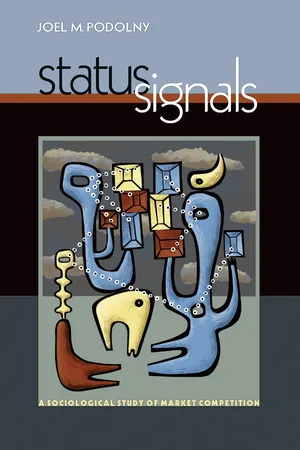
- 304 pages
- English
- PDF
- Available on iOS & Android
About This Book
Why are elite jewelers reluctant to sell turquoise, despite strong demand? Why did leading investment bankers shun junk bonds for years, despite potential profits? Status Signals is the first major sociological examination of how concerns about status affect market competition. Starting from the basic premise that status pervades the ties producers form in the marketplace, Joel Podolny shows how anxieties about status influence whom a producer does (or does not) accept as a partner, the price a producer can charge, the ease with which a producer enters a market, how the producer's inventions are received, and, ultimately, the market segments the producer can (and should) enter. To achieve desired status, firms must offer more than strong past performance and product quality--they must also send out and manage social and cultural signals.
Through detailed analyses of market competition across a broad array of industries--including investment banking, wine, semiconductors, shipping, and venture capital--Podolny demonstrates the pervasive impact of status. Along the way, he shows how corporate strategists, tempted by the profits of a market that would negatively affect their status, consider not only whether to enter the market but also whether they can alter the public's perception of the market. Podolny also examines the different ways in which a firm can have status. Wal-Mart, for example, has low status among the rich as a place to shop, but high status among the rich as a place to invest. Status Signals provides a systematic understanding of market dynamics that have--until now--not been fully appreciated.
Frequently asked questions
Information
Table of contents
- Cover
- CONTENTS
- LIST OF ILLUSTRATIONS
- LIST OF TABLES
- ACKNOWLEDGMENTS
- INTRODUCTION: An Emergent Perspective from an Emergent Field
- CHAPTER ONE: Status, Reputation, and Quality
- CHAPTER TWO: The Matthew Effect (Un)bounded
- CHAPTER THREE: Getting More for Less in the Investment Banking Industry
- CHAPTER FOUR: To Mingle or Not to Mingle with the Hoi Polloi: That Is the Question
- CHAPTER FIVE: The Medium, the Message, and the Signal
- CHAPTER SIX: Status and Invention
- CHAPTER SEVEN: Embeddedness and Entry
- CHAPTER EIGHT: An Evolutionary Perspective on Status Segregation
- CHAPTER NINE: Uncertainty Reconsidered
- CHAPTER TEN: Conclusion
- BIBLIOGRAPHY
- CREDITS
- INDEX